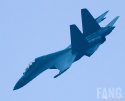And yet you also forgotten that the CJ-10 will also require extensive infrastructures like munitions depot, a harden/camouflage shelters to defend against enemy strikes. Long range radars and surveillance systems (what you think those missiles will guide themselves ?) As well as a trained crew and TEL vehicles. Add all up together and we did be talking about a cost that is no less expensive then any other military system. Then consider that these missiles can also be attacked from base and missions will also have to be planned in advance, targets that are available yesterday might be already moved or reinforced. People always seem to think that a successful cruise missile strike is just as simple as pushing the big red button on the console when it is far from that case.
And then also consider that a CJ-10 have no stealth characteristics whatsoever, and being land based can only follow easily predicable trajectory due to limited fuel load. Fighters can at least refuel in midflight.
No, your assertions are not correct.
A CJ-10 cruise missile can get away with a lot less fixed infrastructure than a J-16.
And as a mobile vehicle, it is easy and cheap to hide in the urban terrain of mainland China.
For the land-attack mission against a fixed location, it doesn't need long-range radars and surveillance.
For the anti-ship mission, it is better to pair CJ-10 missiles with a datalink. There has to be some sort of long-range targeting sensor for an anti-ship missile, even if it is the J-16 performing the role of sensor and CAP, or some other platform.
A CJ-10 has a smaller radar profile than the J-16, and with a datalink can follow a complex flightpath.
And you do realise that J-16 will probably need tanker support to match the 1500km range of a CJ-10 cruise missile.
What if the target relocated ? Or disappeared and is unable to be located/already neutralized? That will be a multimillion strike package being virtually wasted. Being able to be reprogrammed in midflight means nothing if there no other meaningful target to strike.
Datalinks for reprogramming the cruise missiles from the J-16 or another aircraft.
And we can say the same about an even more expensive strike package being wasted were a J-16 to carry air-to-ground weaponry instead of cruise missiles being tasked with the mission.
Not if you consider the fact that again
1) The value of a potential target might be significantly less than that of a single cruise missile, not all targets are multibillion C&C nodes or fuel/munition depots. More mundane targets would be strategically placed pillboxes or artillery batteries.
2) Cruise missile have 0 in the way of defensive countermeasures, meaning a far greater number would have to be expended for a single target compared to other munitions.
Again, you're comparing the wrong thing.
In realistic scenarios, a J-16 won't be able to approach within 100km of a target. It will have to use expensive standoff missiles for its missions. They are essentially the same cruise/supersonic missiles.
Yes, a cruise missile doesn't have any defensive countermeasures. Which is why they would be escorted by J-16s or EW J-15 type aircraft in a high-threat environment.
That is false, if we look through the history of modern battles. Air support greatly increase the effectiveness of ground troop once air superiority is establish or even before that. Well placed airstrikes can break stalemates as well as acting as an aerial borne artillery in terrains whereby conventional artillery support is unfeasible. Such situations would be mobile tank columns which are inherently immune to both artillery and cruise missile strikes.
No, you're wrong. Where are the land battles that Chinese aircraft would support?
They are in Taiwan/Korea/Vietnam/SCS/ECS, which are within 300km of the Chinese mainland.
Using the heavyweight J-16 fighter for these missions is a waste.
These missions are better off assigned to the J-10 or drones, which are more cost-effective for this type of mission.
Considering how the YJ-12 has a much higher top speed= greater success of an attack then a CJ-10 while still maintaing a range beyond the most commonly deployed US SAM which is the SM-2. I find it hard for you to ever consider the opposite.
Which would be subjected to all the limitations I have stated earlier. And I don't see how the LRASM or JASSM will factor into this other than the fact that they can be launched from multiple platforms which only increase their flexibility which further proves my point. (PS: Actually scratch that, both the LRASM and JASSM missiles are planned to be only launched from aircrafts)
Cruise missile are merely another arrow in the quiver, and that is.
You have to get a fighter aircraft within range to a) find a naval target and then b) within range to launch a short range YJ-12 missile
With a JY-12 300km range, we can realistically expect any incoming J-16 strike package to have already been detected and also engaged by a CAP before they can launch.
So they'll have already ditched the JY-12 missiles into the ocean and will only have a limited AAM armanent.
But an incoming strike package of CJ-10 missiles (with cooperative sensors and targeting like LRASMs) is a credible threat that has to be dealt with.
When you add a CAP of J-16s, this presents a strike package which a deadlier and cheaper than just having J-16s doing both CAP and strike
It all goes back to what is the cheapest way to deliver a payload for a specific mission.
We know the large J-16 is suited for long-range missions, which would be in a highly contested environment.
In such environments, it's better for J-16s to concentrate on air-to-air and as targeting sensors because these missions can be conducted without compromising each other.
And then use cruise missiles or similar drone-type aircraft to act as cheap bomb trucks.







